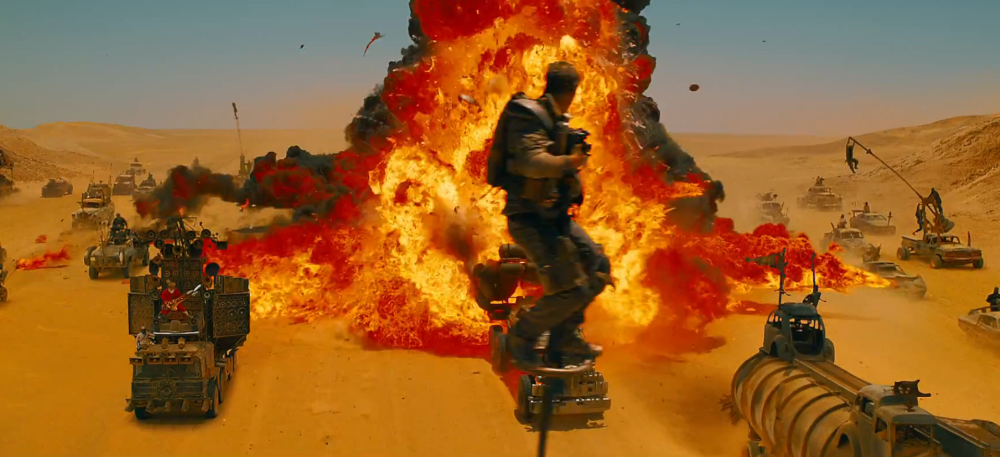
With its operatic scale and overall mythic quality, Mad Max: Fury Road has the feel of a religious epic. Only in this world, the foundational holy documents are kustom-kar rags, driver’s manuals, and a copy of Twisted Metal 2 for PlayStation. George Miller, mastermind of the Mad Max universe since its humble B-movie beginnings in 1979, has perfected the orchestration and execution of on-screen vehicular mayhem. He has given cinema a pantheon-ready heroine in Charlize Theron’s Imperator Furiosa. And with his first non-children’s film since Lorenzo’s Oil in 1992, he has crafted the new high-water mark for large-scale action filmmaking.
Tom Hardy stars as Max Rockatansky, the cop-turned-Outback mercenary previously incarnated by Mel Gibson. With no more than five minutes of phantasmagorical set-up, Miller simultaneously links and detaches Hardy’s Max from Gibson’s: he has the same name, the same M.O., and the same car, but who are these people that haunt his psyche? Where does Fury Road fall on the Mad Max timeline? The truth is, it doesn’t matter. At this point in the series, “Max Rockatansky” is a mythic figure, a folk hero who roams the radioactive-yellow wastelands both trying to survive and helping the last of the just to do the same. Fury Road has the distinct vibe of an oral-tradition tall tale, and Mad Max might as well be Big Joe Mufferaw or Paul Bunyan. Except in this case, the hyperbolic achievements of the character are literalized, turbo-charged, and spot-welded to magnificent two-hour-long car chase.
Despite what the title might lead you to believe, this is mostly Furiosa’s movie. The main narrative thrust of the film is her quest to smuggle a quintet of sex slaves (known as the Five Wives) from the clutches of the dictatorial Citadel leader Immortan Joe (Hugh Keyes-Byrne, his second turn as a Mad Max baddie) to a distant safe haven known only as the Green Place. Max gets initially involved as a victim, captured by the fanatical War Boys of the Citadel, Immortan Joe’s brainwashed army of pale, chrome-domed zealots. In fact, Hardy spends most of the first act of the film either trapped, hanging upside down and used as a literal blood bag, or chained to the front of a battle-ready hot rod as if he were a hood ornament. But he eventually gets free and reluctantly teams up with Furiosa and the Five Wives. “Teams up with” is the key point here: he doesn’t take over their quest, he doesn’t get in the way, he doesn’t get his dick involved. He helps where he can. This usually means ammo runs, terse survivalist wisdom, and demolition derby-levels of combative driving.
The clarity and coherence of the action sequences are nothing short of astonishing, especially given their scale. It’s as if Miller watched all seven Fast and the Furious movies and thought to himself, “Yeah, this is good, but the kids need to see how this is done.” Miller has a nearly-unparalleled mastery of weaving together chases, combat, and drama. Action doesn’t just convey offense and defense or good and bad; it also conveys characterization and motivation. For instance, there’s a mid-chase sequence where Joe is about to shoot Furiosa at point-blank range, when Angharad (Rosie Huntington-Whiteley), pregnant with Joe’s child, shields her. Joe, who sees the girl and the child as his property, doesn’t fire. The film is full of similarly compact visual storytelling, and also just as subtly matriarchal. The core narrative is essentially a woman trying to get five other women out of an oppressive patriarchal regime with the help of a couple of skilled rogues.
Much has already been said about the seamless mix of death-defying practical stunt work and CGI accents in the film, as well as the stunning, impressionistic desert photography, but another standout here is the incredible production design. The Citadel is a supervillain’s lair on crank, carved into a Namibian mountainside and crusted with dirt, sweat, and motor oil. Skull-adorned Art Deco steering wheels are treated like holy icons. War Boys are more or less blessed and sent into battle with a shot of silver spray paint to the gums. Cars are welded onto other cars to make Franken-tanks. A blind man plays a flame-throwing electric guitar plugged into fully functional wall of amplifiers in tandem with a towering rig stacked several stories high with taiko drummers. A man, his eyes bandages due to shrapnel getting lodged in them, double-wields AK47s while proclaiming himself to be the scales of justice. This is a movie of fierce, hard-scrabble imagination and intense kineticism, a Platonic blueprint for what a big-budget action movie can be.
—
Mad Max: Fury Road is now playing in theatres everywhere.
Directed by George Miller; written by Brendan McCarthy, George Miller, and Nico Lathouris; starring Tom Hardy, Charlize Theron, Nicholas Hoult, Hugh Keays-Byrne, Rosie Huntington-Whiteley, Riley Keough, Zoë Kravitz, Abbey Lee, and Courtney Eaton; 120 minutes.



 Derek
Derek
 Isabelle
Isabelle